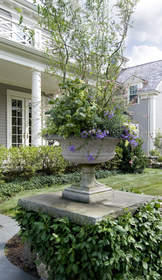WALPOLE, MA--(Marketwire - March 25, 2011) - This winter has many wondering what effect will this weather have on my lawn and gardens? Matt Gramer, president of NatureWorks Landscape Services -- a premier residential landscape company providing design, installation, maintenance, and gardening services to discerning clients south of Boston -- addresses common concerns and predicts what most homeowners should anticipate once the snow melts.
"This winter's weather has been a burden on homeowners for a variety of reasons," states Matt Gramer, President of NatureWorks Landscape Services, "From ice dams to tree branches falling, homeowners are concerned about their properties. What to look for when the snow melts and how to move forward with proper lawn and landscape care as we approach the spring can be challenging for many." Gramer offers the following advice:
Lawn - Snow mold, an active pink, white or gray fungus found in lawns at temperatures just above freezing and in moist conditions, may be prevalent this spring once the snow melts. The best solution for treating this is once the snow is gone, let the lawn dry and rake the affected areas prior to spring fertilization and it's likely to rebound pretty well.
Tree & Shrub Damage - The abundance of snow and ice this winter has taken a toll on many of our favorite New England ornamental trees and shrubs. Many plants will rebound come warmer temperatures, but in some cases some select pruning is suggested to reduce the weight on the ends of branches. Also, plan sound structural pruning to maximize their strength and promote their proper growth habit.
Walkways and Patios - Heaving is common in dry set walkways or patios. One of the benefits is that dry set walkways have joints that allow the paving to flex and avoid cracking, as the ground moves during the winter. Often the paving stones will return to their original elevations, but in the event they do not, they can be reset in either a stone dust or sand setting bed.
Planting Improvements - When replacing damaged plants; consider alternatives that may prove hardier during the winter weather. Consider hardy perennials like Catmint or Daylilies, which are incredibly resilient. There are also some shrubs, generally more herbaceous, that will tolerate heavy snow loads like Spirea, which if damaged could be flush cut it in the spring to generate new tender growth come early summer.
Drainage - Did you have large puddles of water this winter that turned into small frozen ponds? Often there is an easy solution to the majority of drainage issues around the perimeter of your home. Use a combination of drainage pipes and catch basins to encourage the water to go where we want it to go. It is best to address this in the spring to avoid the same problem when the temperature begins to drop again.
Containers - Nothing dusts off the winter cobwebs like color. A container, sometimes called an urn or planter, should be located in a strategic spot, like a front stoop or on your patio, where one can enjoy plants up close. Spring options include some cool season perennials, annuals like pansies, and lots of forced bulbs like Hyacinth, Daffodils, and Tulips.
NatureWorks Landscape Services offers a strong team of talented individuals who deliver exceptional results. From weekly maintenance to landscape construction, Natureworks full line of services provides clients with the simplification and value that comes from working with one source for all their landscape needs.
For more information on NatureWorks, please visit their website at www.natureworkslandscape.com or call 508-660-3139. For press inquiries, contact Joanne DiFrancesco at 781-828-0323 or jdcommunications@verizon.net.
Contact Information:
Press Contact:
Joanne DiFrancesco
JDCommunications, Inc.
781-828-0323
www.jdcomm.biz
